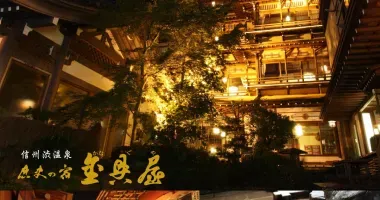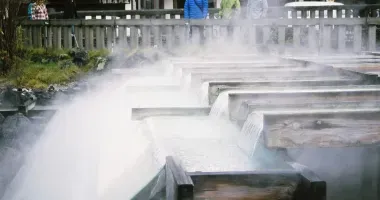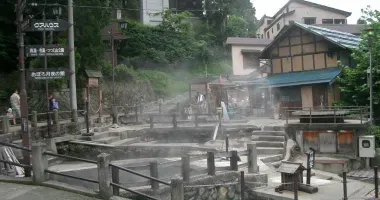Kusatsu Onsen 草津温泉
- Published on : 29/10/2020
- by : Matthew Baxter
- Youtube
Kusatsu Onsen is one of Japan's most famous hot spring resorts. Located in Gunma Prefecture, north-west of Tokyo, it attracts onsen lovers all year round.
Kusatsu Onsen Gunma Prefecture
Kusatsu Onsen Attractions
Kusatsu Onsen is situated in the heart of Gunma, a quiet countryside prefecture. Kusatsu Onsen has become a favourite weekend retreat for people to escape the busy life in Tokyo, so the main reason to come to Kusatsu Onsen is to chill out and take it easy.
Kusatsu Onsen holds the record for the largest volume of hot spring water of any hot spring in Japan and has been drawing visitors to its healing waters since the Edo period. It is estimated that over 32,000 liters of spring water are released every minute which adds up to around 230,000 barrels of hot water every day.
The waters of the onsen, which originate on the pristine pine and larch forests of nearby Mount Shirane, an active volcano at an altitude of 2160 meters, are known for their high acidity which can even dissolve metal.
The chemical make-up of the water at Kusatsu Onsen includes sulphur, iron, alum, aluminium sulfate, chloride and arsenic with water temperatures ranging from 60 to 67 degrees Centigrade. The anti-bacterial nature of the water is thought to help cure a number of diseases including arthritis, diabetes, fatigue, hardening of the arteries, high blood pressure and muscular ailments.
History
The German physician Erwin von Baelz (1849-1913), who was a doctor at the Japanese court in the late 1800's and treated some of the most famous people in Japan at the time, such as the Emperor Meiji and Prime Ministers Ito Hirobumi and Yamagata Aritomo, did much to popularize the medicinal effects of Kusatsu Onsen in the modern period.
The combination of clear water and mountain air reminded him of the spa town of Karlsbad in his homeland. The Baelz Memorial Hall is a small museum, a little out of town, dedicated to the good doctor, who did so much to put Kusatsu firmly on the hot spring map.
Yubatake
Kusatsu Onsen is well known for its 'Yubatake', which means 'hot water field'. This is a huge area right in the center of the town, where the water is divided and cooled. It is all in the open air, so makes for some great, iconic photos. There are also many restaurants and bars around Yubatake, so most people come here in the evening.
Next to Yubatake is the Yumomi performance area. Located inside the Netsu-no-Yu Bathhouse, this special performance sees dancers singing Japanese folk songs, while dancing around the hot spring baths. During this performance the water is cooled down using large wooden planks. Some people from the audience are selected to participate, so be ready to dance! Performance times are shown outside Netsu-no-Yu Bathhouse (500 yen).
Before visiting one of the many hot springs, many people visit Sai-no-Kawara Street. This is a very pleasant street full of very stylish, old fashioned ryokan or minshuku and loads of great souvenirs and traditional sweet shops. Even if you are on a tight budget, it's a great place for some window shopping.
Mount Shirane is the source of all the hot spring water in Kusatsu Onsen. During the summer and autumn it is possible to walk up to the top for a spectacular view over the mountains. (Although presently closed due to volcanic activity in the crater).
Take the Seibu Kogen bus from Kusatsu Onsen Bus Terminal to Mount Shirane bus stop. From here it is a short 10 minute walk to the top, where you can see the volcanic water in the crater of Mount Shirane.
Kusatsu Hot Springs
Kusatsu Onsen has been a top location for hot springs for centuries and is one of Japan's "Three Famous Springs" (Nihon Sanmeisen) along with Arima Onsen in Hyogo Prefecture near Kobe and Gero Onsen in Gifu Prefecture.
Yubatake, in the center of town, has multiple free to use foot baths around it. Yubatake is a great place to come in the evening with a beer, when the crowds come out in their yukatas and other Japanese casual evening gear.
Sai-no-Kawara Park, on the west side of town, is an amazing park full of volcanic streams, pools and large clouds of steam. It also has a large outdoor hot spring called Sai-no-Kawara Onsen. Entrance costs 500 yen (open 9 am to 8 pm). Sai-no-Kawara Park is a rather eerie but fascinating place to visit.
Another popular hot spring is Otaki-no-yu. Located five minutes walk from Yubatake, this hot spring has a variety of indoor and outdoor baths, as well as a sauna and restaurant. Entrance costs 800 yen (open 9 am to 9 pm).
Kusatsu Onsen Center has a large bath adjacent to a lovely white birch grove. Altogether there are six baths here with a cave bath, jacuzzi and an ultra-infrared sauna. Relax afterwards in Kusatsu Onsen Center's bar and restaurant.
Goza-no-yu housed in a reproduction Edo period wooden building also offers a variety of bathing experiences.
Yu-kemuri Tei is a roofed, cottage style footbath located near the Yubatake, which is a free facility, ideal for relaxing and chatting to your friends and neighbors. The footbath is a reconstruction of the original Matsu-no-yu public footbath that stood here during the Edo period.
Therme Therme is a modern spa facility where visitors wear swimsuits in the indoor swimming pool and there are various kinds of hot baths.
Chiyo-no-yu, Jizo-no-yu and Shirahata-no-yu are three public bathhouses that are generally open to non-residents. Kick it with the locals in these informal community baths but please respect the etiquette of these traditional bathing houses populated by residents.
Kusatsu Kokusai Ski Resort is close to Sai-no-Kawara Park and after a hard day on the slopes it is traditional to soak in a hot bath. The ski run here is one of the longest in Japan at close to 8 km. Advanced skiers tend to stick to the higher slopes while beginners can enjoy the broad, gentle run at the base.
Getting around Kusatsu Onsen
The easiest way to get around Kusatsu Onsen is to use the Kusatsu Loop Bus. It's only 100 yen per ride and all the buses take an easy to understand route around town. Press the button to alert the driver when the next stop is yours, and then insert your 100 yen into the fare box when you get off the bus.
Access - Getting to Kusatsu Onsen
From Tokyo Station, take the JR Joetsu Line to Takasaki, Gunma. After this take a local train on the JR Agatsuma Line to Naganohara-Kusatsuguchi. A JR bus then takes you directly to Kusatsu Onsen in 30 minutes. The entire journey by train and bus costs about 8,000 yen and takes around 2 hours, 30 minutes to 3 hours.
Be sure to go straight to the bus stop after getting off the train at Naganohara-Kusatsuguchi as they are often timed to leave 10 minutes or so after the train arrives. The Japan Rail Pass is valid for both trains and the bus to Kusatsu Onsen. The JR East Pass and JR Tokyo Wide Pass are not valid on the bus from Naganohara-Kusatsuguchi to Kusatsu Onsen Bus Terminal.
There are also direct Limited Express trains from Ueno Station in Tokyo to Naganohara-Kusatsuguchi, but only a few of these operate a day (5800 yen, about 3 hours).
There are also Express Buses from Shinjuku Station to Kusatsu Onsen (3000 yen, 4 hours). It is possible to leave Shinjuku at night and arrive early morning in Kusatsu Onsen, and vice versa. Kusatsu Onsen's bus station is next to the Town Office in the centre of town.
From Karuizawa travel to Takasaki and then on to Naganohara-Kusatsuguchi.


















